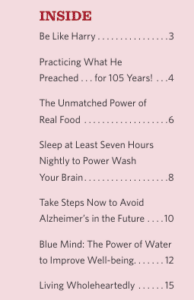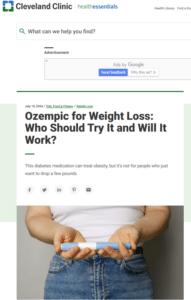Summary
- Newsletters are a valuable tool for hospitals looking to engage patients and build relationships.
- Standout health newsletters offer helpful, focused, and consistent quality information.
- Successful newsletters keep a positive tone, repurpose quality web content, are well-rounded, and harness stories straight from patients.
Are newsletters still in?
The data says yes. One study found that 99% of email users still check their inboxes every day, with some checking as many as 20 times a day. (“Some” is us — that Outlook tab stays open.)
Of course, users don’t read every email — most of us receive far too many to make that possible — but we still see who’s putting in the effort to connect with us regularly. And that’s worth something.
Hospital newsletters are an inexpensive and undemanding way to build relationships with patients. But the digital landscape is crowded with thousands of other newsletters from hospitals, healthcare practices, and specialty clinics.
How can you stand out? We discuss the do’s and don’ts of newsletters and offer 4 tips for making your newsletter your subscribers’ favorite.
Hospital newsletter crash course
What’s the difference between a health newsletter that gets read regularly and one that gets sent to the trash? (Or, gasp, drives unsubscribes?)
Let’s break it down.
Anatomy of a successful hospital newsletter
The newsletters that work best are:
- Helpful, giving readers health information they can use
- Focused, with a niche (like heart care) and not a hodgepodge of organization-wide news
- Consistent, delivering high-quality content regularly
What to avoid in your health newsletter
What don’t subscribers like in a medical newsletter? These are the biggest complaints:
- Asking for too much: Don’t hit readers over the head with overt asks, such as pleas for donations or appointments.
- Too formal: Readers don’t like emails that read like stiff press releases about organization news or clinical services.
- Self-serving: Engaging newsletters don’t focus on what the hospital wants to say — they focus on what their subscribers want to read.
4 newsletter writing tips from healthcare email marketers
Now that you know the do’s and don’ts, check out our writers’ best tips and 4 exemplary hospital newsletter examples.
1. Keep the tone light
People who sign up for your chronic disease newsletter do not need to be reminded they’re sick. Don’t post worrisome statistics or basic disease information. Instead, emphasize how to live *well* with the condition.
Positive medical newsletter example
The “From the Heart” newsletter from Saint Luke’s Cardiovascular Associates does this well. The title nods to its focus on cardiovascular health while implying that articles will be informative, honest, and compelling.
Check out the table of contents from this sample newsletter.
If you were expecting a heart-healthy living manifesto, you’d be wrong. This newsletter is brimming with stories about wellness. Find out about the daily walking routine of former U.S. president Harry Truman (whose hometown is near the clinic). Or how a diet of natural, unprocessed food slows the progression of chronic disease. Heart disease is a theme throughout the newsletter, but a subtle one.
2. Use health newsletter articles to drive readers to your blog
Why reinvent the wheel? If you’re already creating strong blog posts, repurpose and distribute your web content for new audiences. Patients and families who may not know about your blog may become regular visitors, improving your web analytics.
Children’s hospital newsletter example
Look to Seattle Children’s Hospital’s “my Good Growing” newsletter as an example.
High-quality stock photos, easy-to-scan headlines, and succinct descriptions make it simple for time-pressured parents to find helpful blog content. Articles are grouped by broad topics, such as injury prevention, and life stages, from toddlers to teens. And they include links to articles from the American Academy of Pediatrics.
3. Create well-rounded content
Your subscribers lead busy lives, but health and well-being are always on their minds. Engage them with topics that pique their interest, answer a burning question, or offer surprising health facts.
Engaging healthcare newsletter example
Cleveland Clinic’s award-winning health newsletter includes content that interests a variety of readers. It includes evergreen topics, such as sun protection, and trendy issues, like their take on the latest weight loss drug. All articles have a health angle and a general interest appeal, such as getting kids to eat veggies.
Robust content helps you appeal to health-conscious audiences who might not require your services. Providing click-worthy, easy-to-read content establishes your brand as a credible source of information. And if their health needs change, they are more likely to turn to your organization for care.
4. Tell your readers’ stories
Some of the most compelling articles and story ideas can come from your audience. Why not tap into the stories of patients who had a positive experience with your hospital?
Story-driven health newsletter example
Check out MSK News from Memorial Sloan Kettering Cancer Center. Each issue of MSK News is about “the stories of our patients and their families; and our researchers, doctors, nurses, and staff.”
Crowdsourcing ideation is another way to gain the inside scoop on topics your audience is curious about. You can also send periodic surveys to your readership or create prompts on your sign-up page to capture input from your newest subscribers.
Get support with your newsletters
Need more hospital newsletter ideas or writers to execute them? We’re here for you. Partner with experienced hospital newsletter writers to engage your patients.
Are you surprised?
We practice what we preach about newsletters at Aha Media. Check out ours to swipe our engagement tactics and learn more about producing healthcare content.
Subscribe to our newsletter to gain more inspo.






